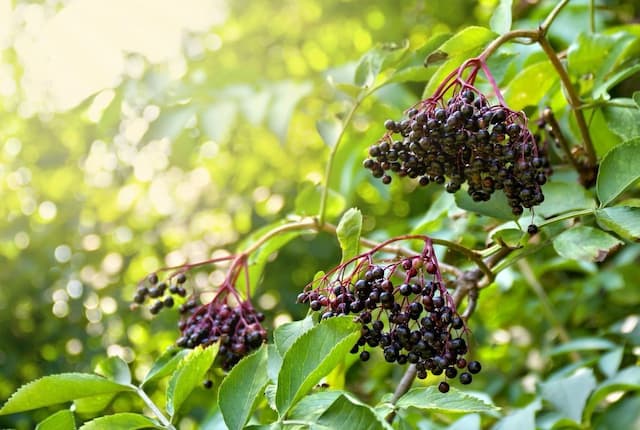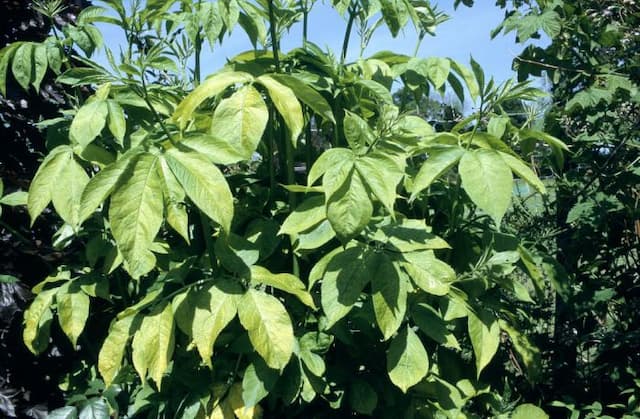Japanese Snowball Viburnum plicatum f. plicatum Triumph = 'Trizam'
![Japanese snowball [Triumph]](/_next/image?url=https%3A%2F%2Fplants-admin.emdemapps.com%2Fimages%2Fplants%2F%2Fimages%2F604b5fa3a9f15.png&w=3840&q=75)
ABOUT
The Viburnum plicatum Triumph, which can commonly be referred to as Japanese Snowball, is a deciduous shrub that is noted for its striking and ornamental appearance. This plant showcases layers of deeply veined, dark green leaves that have a somewhat wrinkled or crinkled texture, giving a rich, textured look to the foliage. The leaves typically change to a vibrant reddish-purple color before they fall off during the autumn season. One of the most distinctive features of the Japanese Snowball is its profusion of white, lacecap-style flowers that bloom prolifically in spring. These blossoms are composed of large, sterile outer flowers that encircle smaller, fertile flowers, creating a delicate and showy display that resembles snowballs, hence its common name. The flowers are known for their symmetrical arrangement and their ability to add a touch of elegance to the landscape. Following the flowering period, this shrub may produce small, red berry-like fruits that gracefully transition into a black color as they mature. These fruits can add an additional layer of visual interest to the plant, though they are not considered a significant feature when compared to the remarkable spring bloom. It should be noted that the overall shape of the Japanese Snowball plant is multi-stemmed and bushy, often with a somewhat rounded form. Its branches can create a horizontal, tiered structure that adds to the plant's architectural beauty. This growth habit contributes to its use as a focal point in garden designs, where its ornate characteristics can be fully appreciated.
About this plant
 Names
NamesFamily
Adoxaceae
Synonyms
Japanese Snowball, Doublefile Viburnum
Common names
Viburnum plicatum f. tomentosum 'Trizam', Viburnum tomentosum 'Trizam'
 Toxicity
ToxicityTo humans
Japanese snowball is not considered highly toxic to humans. However, it is generally recommended that people do not eat the berries or other parts of ornamental plants, as they can cause stomach upset or other gastrointestinal symptoms if ingested in large quantities.
To pets
Japanese snowball is also not highly toxic to pets. But as with humans, the ingestion of plant parts, especially berries, can lead to gastrointestinal discomfort, such as vomiting or diarrhea, if consumed in significant amounts. It is best to prevent pets from eating these plants to avoid potential upset.
 Characteristics
CharacteristicsLife cycle
Perennials
Foliage type
Deciduous
Color of leaves
Green
Flower color
White
Height
8 feet [2.4 meters]
Spread
10 feet [3 meters]
Plant type
Shrub
Hardiness zones
5
Native area
Japan
Benefits
 General Benefits
General Benefits- Ornamental Appeal: Doublefile Viburnum features elegant horizontally tiered branches with white lace-cap flowers in spring that add ornamental interest to any garden.
- Four Season Interest: This plant provides visual interest throughout all seasons with flowers in spring, red berries in summer, colorful foliage in fall, and textured bark in winter.
- Wildlife Attraction: The berries produced are a food source for birds and the flowers can attract pollinators like bees.
- Low Maintenance: Once established, Doublefile Viburnum is low maintenance, requiring minimum care beyond basic watering and occasional pruning.
- Durable: It is adaptable to a wide range of soil conditions and can tolerate some drought once well-established, making it a hardy addition to the landscape.
- Privacy and Screening: The dense foliage and moderate height of Doublefile Viburnum can provide privacy and act as a natural screen in garden spaces or along property lines.
- Compact Size: 'Trizam' is a compact cultivar, making it suitable for smaller gardens where space might be limited.
 Medical Properties
Medical PropertiesThis plant is not used for medical purposes.
 Air-purifying Qualities
Air-purifying QualitiesThis plant is not specifically known for air purifying qualities.
 Other Uses
Other Uses- Photography backgrounds: The dense foliage and flowers of the Japanese snowball can provide an attractive backdrop for portrait and macro photography.
- Natural fencing: By planting Japanese snowball shrubs closely together, they can form a natural, decorative screen or fence for privacy.
- Floral arrangements: The spherical flower clusters of the Japanese snowball can be used as fresh or dried arrangements to decorate indoors.
- Cultural celebrations: In some cultures, the blossoms may be used during festivals or celebrations as a symbol of spring or new beginnings.
- Habitat creation: The plant can be used in wildlife gardens to provide shelter and nesting sites for birds.
- Erosion control: Their root systems can help stabilize slopes and control erosion in certain landscape situations.
- Education: The plant can be used as a teaching tool in horticulture classes to illustrate pruning techniques or plant structure.
- Winter garden interest: With a strong branch structure, the Japanese snowball can add visual interest to a winter garden when other plants have died back.
- Sound barrier: When planted in mass, they can help reduce noise pollution from roads or neighbors.
- Topiary art: Skilled gardeners can prune Japanese snowball shrubs into various shapes for decorative topiary art in gardens and parks.
Interesting Facts
 Feng Shui
Feng ShuiThe Japanese Snowball is not used in Feng Shui practice.
 Zodiac Sign Compitability
Zodiac Sign CompitabilityThe Japanese Snowball is not used in astrology practice.
 Plant Symbolism
Plant Symbolism- Renewal: The Viburnum plicatum, commonly known as Japanese Snowball, blooms with fresh white flowers each spring, symbolizing new beginnings and the renewal of life.
- Protection: With its dense growth habit, Japanese Snowball has been known to signify safety and shelter, often planted around homes for protection.
- Abundance: The plentiful clusters of flowers can represent abundance and wealth, as the plant generously displays its blooms.
- Purity: The pristine white flowers of the Japanese Snowball exemplify purity and innocence, often associated with clarity of thought and purpose.
- Persistence: As a plant that can thrive in various conditions, the Japanese Snowball is a symbol of persistence and the ability to persevere through challenges.
 Water
WaterJapanese Snowball (Viburnum plicatum f. plicatum 'Trizam') prefers evenly moist soil, so it's important to water it deeply, especially during the first growing season to establish a deep, extensive root system. Water the plant once a week with about 1-2 gallons, depending on the climate and soil conditions. During hot, dry periods, it may require additional water, perhaps twice a week, but always check the soil moisture before watering to prevent over-watering. Reduce frequency in winter, when the plant is dormant, to every couple of weeks unless there's significant rainfall.
 Light
LightThe Japanese Snowball thrives best in full sun to partial shade. It should be placed in a spot where it can receive at least four hours of direct sunlight each day, though some afternoon shade is beneficial in particularly hot climates. Avoid deep shade since it can result in reduced flowering and a less dense plant form.
 Temperature
TemperatureJapanese Snowball plants prefer temperate climates and can usually handle temperatures ranging from -10°F to 95°F. However, they thrive best when the temperature is between 60°F and 80°F. They are hardy in USDA zones 5 through 8, which means they can withstand winter lows down to -20°F but may suffer if temperatures exceed the 95°F mark in summer.
 Pruning
PruningPrune your Japanese Snowball after it has finished flowering in late spring to maintain its shape and to remove any dead or diseased wood. Thin out old branches to encourage new growth which will be more vigorous and produce better flowers the following year. Pruning can be done annually, but heavy pruning should only be done every few years to prevent stress to the plant. The best time for heavy pruning is late winter or early spring before new growth begins.
 Cleaning
CleaningAs needed
 Soil
SoilJapanese Snowball 'Trizam' thrives best in a soil mix rich in organic matter with good drainage. The ideal pH for this plant ranges from slightly acidic to neutral, around 5.5 to 7.0. A mix of garden soil, compost, and peat moss or pine bark will create an optimal environment for root health and growth.
 Repotting
RepottingJapanese Snowball 'Trizam' does not typically require frequent repotting as it's commonly grown as a landscape shrub. When grown in containers, repot every 2 to 3 years or when the plant becomes root-bound to encourage continued growth.
 Humidity & Misting
Humidity & MistingJapanese Snowball 'Trizam' is adaptable to a range of humidity conditions and does well in the humidity levels found in most outdoor garden environments without requiring any special humidity adjustments.
 Suitable locations
Suitable locationsIndoor
Ensure bright, indirect light and room to grow.
Outdoor
Plant in partial shade, water regularly, and mulch.
Hardiness zone
5-8 USDA
 Life cycle
Life cycleViburnum plicatum f. plicatum 'Triumph' or Doublefile Viburnum, begins its life cycle as a dormant seed, which will germinate when conditions are suitable, typically in moist, well-drained soil and with adequate warmth. After germination, the seedling emerges and establishes a root system, developing into a young plant with characteristic leaves that are deeply veined and arranged in opposite pairs. As the plant matures, it enters a vegetative state, growing steadily in height and spread, and producing sturdy branches that showcase its distinctive horizontal branching pattern. Once maturity is reached, which can take several years, the plant begins its reproductive stage, blooming in late spring to early summer with clusters of white, showy flowers that attract pollinators and are followed by red to black fruit, which serves as food for birds. After the blooming period, the plant enters a phase of senescence in late autumn, where leaves may change color and drop, however, as a deciduous shrub, it can endure winter dormancy and resurge the following spring. This cycle repeats annually throughout the plant's lifespan, which can extend to several decades if it is grown in optimal conditions and receives proper care.
 Propogation
PropogationPropogation time
Spring-Early Summer
The most popular method of propagating the Doublefile Viburnum, specifically the Viburnum plicatum f. plicatum Triumph 'Trizam', is through softwood cuttings. This is typically done in late spring or early summer when new growth is soft and flexible. To do this, a gardener would cut a 4 to 6-inch-long (about 10 to 15 cm) section of a healthy branch, making sure that it has several leaves. The lower leaves are removed, and the cut end is dipped in rooting hormone before being placed in a well-draining potting mix. The cutting should then be kept in a humid environment with indirect sunlight until roots have developed, which usually takes a few weeks. Once rooted, the cutting can be transplanted into the garden or a larger pot to grow on.



![Elder [Black Tower]](/_next/image?url=https%3A%2F%2Fplants-admin.emdemapps.com%2Fimages%2Fplants%2F%2Fimages%2F604b5cad99578.png&w=640&q=75)





